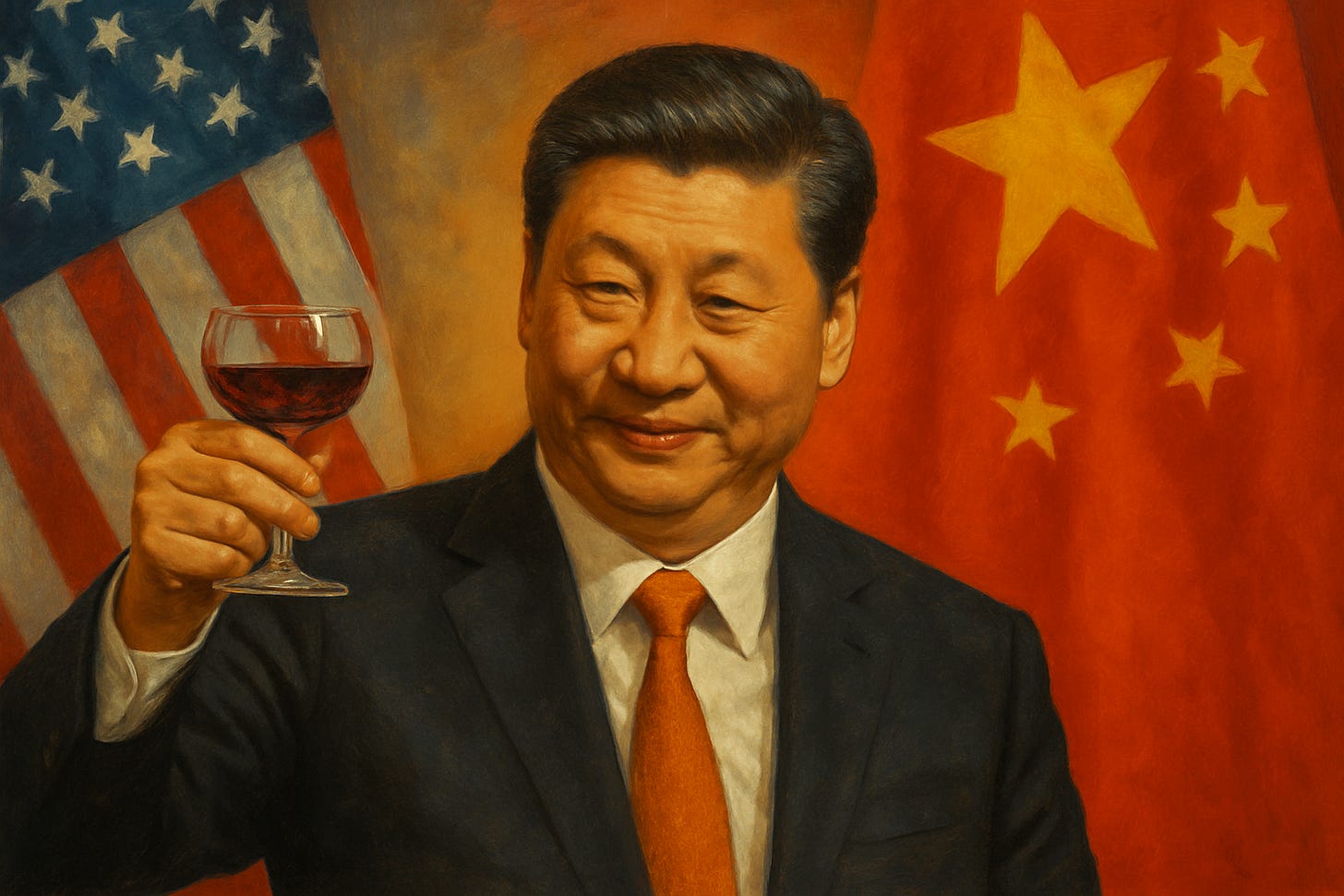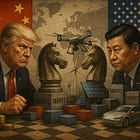Made in Vietnam (Actually China)
China's global exports hit 20% of GDP despite US trade restrictions
The tariffs worked, on paper at least, until you looked at what China was actually doing.
By June 2025, monthly US imports from China had cratered by 50 percent. The bilateral trade deficit hit $9.5 billion, the lowest in twenty-one years. Politicians from both parties declared victory in the trade war that began under Trump in 2018 and continued under Biden through 2025.
There was just one problem: China’s total global exports barely flinched.
American tariffs disrupted bilateral trade with China, but they failed spectacularly at their stated goals. Instead of weakening China’s export engine or restoring US manufacturing, the tariffs functioned as a toll on global supply chain reconfiguration, not a wall. Chinese goods still reach global markets, including American ones, just through more circuitous and expensive routes.
Meanwhile, China cemented its dominance in next-generation industries like electric vehicles, batteries, and solar technology.
The real trade war isn’t the one politicians think they’re fighting.
China’s total global exports hit 20 percent of GDP in 2024 and are projected to grow 8.3 percent in 2025. The IMF quietly concluded that US tariffs proved less disruptive than initially expected.
The tariffs didn’t stop Chinese goods. They just made them take a detour.
Tariffs on Chinese widgets? Manufacturers ship those widgets to Vietnam or Mexico instead, add minimal final assembly, slap on a Made in Vietnam sticker, then waltz into America tariff-free. Or they bypass America entirely and sell to Africa, Latin America, and Southeast Asia.
Since April 2025 alone, an estimated $77 billion in Chinese goods got rerouted through ASEAN countries. Exports to Africa surged 56 percent year-over-year, Latin America up 15 percent, Southeast Asia up 15.6 percent.
Global trade volume in tariff-targeted products actually increased during the trade war.
Even Europe became a dumping ground. US tariffs during 2018-2019 directly caused a 2-3 percent increase in EU imports from China.
Remember all those promises that China would pay for the tariffs?
Economic analysis shows the opposite happened. US importers absorbed the tariff costs almost one-for-one. Chinese exporters didn’t discount their prices. They kept charging what they were charging and let American businesses eat the tax.
Why? Because American companies can’t easily find substitutes. China spent decades building manufacturing dominance that can’t be replicated overnight.
So US importers pay up, then pass those costs to consumers. The trade war added roughly 0.3 percent to the Consumer Price Index. Retailers are steadily raising prices on furniture and appliances.
It’s a regressive tax dressed up as economic nationalism.
Circumvention became routine. The de minimis exemption, letting shipments under $800 enter duty-free, became a superhighway for low-value Chinese e-commerce. Companies routed goods through third countries with minimal assembly just to change origin labels.
The US finally suspended the exemption in May 2025, but that loophole existed for years. There’s a widening gap between US import records and China’s export records, suggesting official data understates how much Chinese content still enters the country.
China also gamed the timing, front-loading shipments ahead of tariff announcements.
Here’s where the stakes escalate.
While America was busy fighting yesterday’s trade war over cheap textiles and basic electronics, China moved up the value chain. The Old Three are being replaced by the New Three: electric vehicles, lithium-ion batteries, and solar cells.
China doesn’t just compete in these sectors. It dominates them.
World’s largest producer and exporter of solar cells. Major global player in lithium-ion batteries. Dominant force in EVs.
Biden responded with 100 percent tariffs on Chinese EVs and 25 percent on batteries. Sounds tough, except China accounted for only 1.1 percent of new energy vehicle imports to the US in 2023.
These aren’t tariffs responding to trade imbalances. They’re preemptive industrial policy, trying to strangle a competitive threat before it arrives.
The problem? The rest of the world still needs those Chinese batteries and solar cells because there are no competitively priced alternatives at scale.
China’s dominance guarantees global demand regardless of what America does.
Tesla is ordering suppliers to eliminate China-made components from US vehicle production within two years. That’s not reshoring. That’s decoupling, fragmenting supply chains at enormous cost and making everything more expensive for consumers.
The logical response would be multilateral coordination. Get Europe, Japan, Canada, and Mexico on the same page.
Instead, there’s fragmented panic.
Canada slapped tariffs on Chinese EVs, steel, and aluminum. Mexico steadily raising tariffs. Not because they care about fair trade, but because they’re terrified of being accused of enabling Chinese transshipment.
American tariff policy forced allies into their own protectionist measures just to maintain US market access.
There’s talk of common North American tariffs on China, which would be genuine coordination except it’s driven by panic rather than strategy.
So what did years of escalating tariffs accomplish?
Made Chinese goods more expensive for American consumers. Pushed China to diversify away from US dependence, strengthening ties with the Global South. Created opportunities for tariff arbitrage without reducing Chinese manufacturing capacity. Forced allies into defensive protectionism.
What didn’t happen: bringing back manufacturing at scale, reducing China’s export strength, or creating competitive alternatives in next-generation technology.
Tariffs are a toll, not a wall.
Chinese goods still flow, through Singapore instead of Seattle, through Monterrey instead of Memphis. The trade deficit shrinks on paper while American consumers pay higher prices and China strengthens relationships with the bulk of humanity outside the West.
The tariffs are fragmenting supply chains along geopolitical lines. But China’s global export volumes remain stable because the world is bigger than America, and most of it doesn’t share American concerns about Chinese economic power.
Three things become clear.
First, bilateral tariffs without multilateral coordination are theater, not strategy. If the goal is genuinely constraining Chinese economic behavior, that requires coordinated tariff policies with Europe, Japan, and North American partners that close transshipment loopholes. The fragmented protectionism happening now just creates opportunities for China to exploit gaps.
Second, preemptive tariffs on sectors where China already dominates are shutting the barn door after the horses left. The fight over EVs and batteries needed to happen a decade ago through industrial policy and R&D investment, not now through tariffs. Competitive alternatives to Chinese dominance require massive domestic investment, not import taxes.
Third, the conflict has escalated without building the domestic industrial capacity needed to compete where it matters. Supply chain decoupling is happening, but at enormous cost and without a clear endpoint.
The question isn’t whether to compete with China. It’s whether America is willing to make the investments necessary to compete effectively.
The tariffs don’t work the way politicians promised. They work exactly how China wants them to, and that’s the only scorecard that matters.




